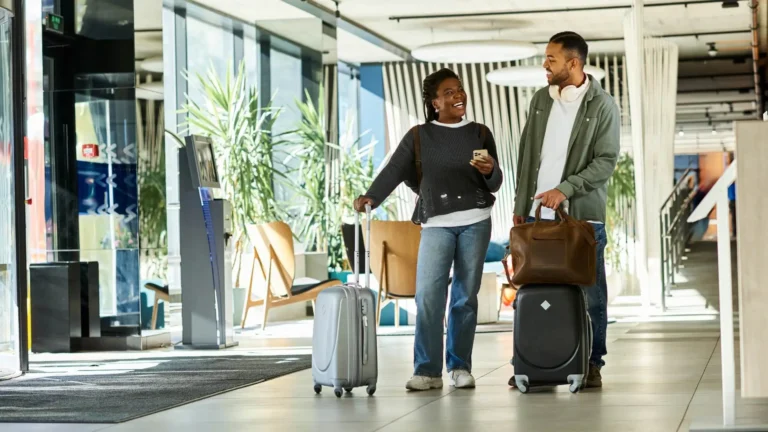Table of Contents
Air travel is rarely as straightforward as buying a ticket and boarding a plane. In today’s airline industry, extra costs often pile up quickly, and one of the most frustrating expenses for travelers is baggage fees. These charges, once included in the ticket price, have now become a steady source of revenue for airlines worldwide.
What makes baggage fees even trickier is their inconsistency. Some airlines charge for even the first checked bag, while others let you bring two for free. Fees also vary depending on whether you pay in advance, at check-in, or at the gate. For families or frequent travelers, baggage costs can add hundreds of dollars to a trip, sometimes making a “cheap ticket” not so cheap after all.
The good news is that baggage fees can be managed with the right strategy. By knowing when to avoid them altogether, when to combine luggage smartly, and when to prepay in advance, you can take control of your travel budget. This playbook breaks down the options and offers practical tips to minimize your costs, while still ensuring a stress-free journey.
Along the way, we’ll also explore how tools like Beem’s Budget Planner help travelers anticipate and manage these costs without surprises. With smart planning, baggage fees don’t have to derail your travel finances.
The State of Baggage Fees Today
Why Airlines Charge for Bags
Not long ago, most airlines included checked baggage in the cost of a ticket. But over the past two decades, the industry shifted toward an “unbundled” model, where the base fare covers only the seat and minimal services. Everything else, from food to baggage, comes at an additional cost.
This move allowed airlines to advertise cheaper headline fares, which look appealing during searches. But once travelers add baggage, seat selection, and meals, the real cost climbs significantly. Baggage fees alone contribute billions in revenue to airlines annually, making them one of the most reliable profit streams.
For airlines, charging separately for bags also helps manage costs. Fewer bags mean lighter planes and lower fuel consumption. It also discourages overpacking, ensuring smoother boarding and quicker turnaround times. From their perspective, it’s as much about efficiency as it is about revenue.
For passengers, however, baggage fees often feel like a hidden tax. The frustration isn’t just about paying extra — it’s about the unpredictability. Fees differ not only between airlines but also across routes and ticket classes, which leaves travelers unsure of what they’ll pay until the last step of booking.
The Hidden Cost of Travel
When comparing flights, many travelers focus only on the ticket price. Yet baggage fees can easily push a “bargain” flight into expensive territory. A $150 round-trip fare may double in cost if you’re paying $60 per bag each way. For families traveling with multiple suitcases, the cost can be even higher.
The psychological trick here is intentional. Airlines lure passengers with low base fares, then recover margins with add-ons. Many people only discover the true price of their trip when they’re checking in, leading to unpleasant surprises at the airport counter.
In real-world cases, travelers have been forced to pay more in baggage fees than the base cost of their ticket. This shift has made baggage fees one of the most significant and disliked add-ons in modern travel. Understanding these patterns is the first step to working around them.
Read related blog: Top HYSAs for Frequent Travelers (Low International Fees)
Strategy 1: Avoid Baggage Fees
Travel Light With Carry-Ons
The simplest way to avoid baggage fees is to travel light. Most airlines allow one personal item and one carry-on bag for free. By mastering the art of minimalist packing, you can skip checked luggage entirely.
Investing in the right gear helps. Lightweight, hard-shell carry-ons maximize packing space while staying within size limits. Packing cubes keep items organized and allow you to compress clothing for extra room. Shoes, jackets, and heavier items can be worn during boarding to save space in your bag.
For short trips or business travel, this strategy is particularly effective. With everything at hand, you also avoid waiting at baggage claim or worrying about lost luggage. Traveling with just a carry-on not only saves money but also time and hassle.
However, carry-on rules differ between airlines. Budget carriers often charge for larger cabin bags, so it’s essential to check the fine print before committing to this approach.
Leverage Airline Credit Cards and Loyalty Programs
Another way to sidestep baggage fees is through airline partnerships. Many airline-branded credit cards include free checked bags as a perk. Depending on the card, this benefit may apply to the primary cardholder and even companions on the same reservation.
Frequent flyers can also take advantage of loyalty programs. Elite status often includes free baggage allowance, and in some cases, multiple free bags. For regular travelers, this can save hundreds of dollars annually.
These programs do require commitment. Credit cards come with annual fees, and elite status requires meeting travel thresholds. But for those who travel often, the trade-off is usually worth it.
Choose the Right Airline
Not all airlines treat baggage the same. For example, Southwest Airlines famously allows two free checked bags for every passenger. For those traveling with families or longer trips, this policy can make a significant difference compared to other U.S. carriers that charge from the first bag.
Even among international airlines, policies differ. Some include at least one free checked bag on long-haul flights, while others follow a stricter, fee-heavy approach. The key is to compare not just ticket prices but also baggage policies when booking. Sometimes a slightly more expensive ticket can actually save money once baggage fees are factored in.
Strategy 2: Combine Bags
Traveling as a Group
If you’re traveling with family or friends, combining bags is one of the easiest ways to cut costs. Instead of everyone checking separate luggage, share the space and distribute items among fewer bags.
For instance, a family of four could condense into two larger checked bags instead of four smaller ones. While this requires coordination, it can save $100 or more depending on the airline’s fee structure.
This approach also simplifies travel logistics. Fewer bags mean less to carry through airports, less time at baggage claim, and fewer chances for luggage to go missing. It’s a win-win when executed carefully.
Packing Smarter Together
The key to combining bags successfully is communication. Before packing, decide what items can be shared. Toiletries, chargers, and even certain clothing can be distributed across fewer bags to avoid duplication.
Traveling with children often requires additional gear, but even then, combining items can help. Parents can split essentials into joint bags and reduce unnecessary extras.
Packing together also builds a sense of teamwork. Families and groups can treat the packing process as part of trip preparation, ensuring everyone contributes while still staying within weight limits.
Weight Distribution Hacks
Even when combining bags, you’ll need to watch out for overweight charges. Airlines typically charge significantly more if a bag exceeds the weight limit, sometimes doubling or tripling the fee.
One smart approach is to distribute weight at the airport if a bag is close to the threshold. Many travelers shift heavy items like books, shoes, or electronics into carry-ons to stay under the limit. Some even carry portable luggage scales to avoid surprises before heading to the airport.
By working together, groups can optimize both the number of bags and the weight distribution, cutting fees without sacrificing essentials.
Strategy 3: Prepay for Bags
Why Prepaying Saves Money
Many airlines charge less if you pay for bags in advance online rather than at the airport counter. The savings may seem small — often $5–$15 per bag — but across multiple travelers and trips, the difference adds up.
Prepaying also reduces stress. By knowing your baggage costs upfront, you can avoid the anxiety of unexpected fees at check-in. This makes the travel experience smoother and faster, especially for families juggling multiple bags.
How to Prepay Efficiently
The best time to prepay is during booking. Most airlines offer a discount when you add bags at checkout. If you miss this window, you can usually still prepay later through the airline’s app or online check-in portal.
It’s worth comparing the price difference between booking time and later prepayment. In some cases, paying right away is cheapest, while in others, the fee remains the same until you arrive at the airport.
Prepaying is especially helpful for budget carriers, which often make prepayment cheaper and sometimes the only option. These airlines may even penalize travelers who wait until check-in with higher fees.
Risk vs. Reward of Prepaying
The downside of prepaying is flexibility. If your trip changes or you cancel, prepaid baggage fees are often non-refundable. That means you may lose the money if plans fall through.
However, for most travelers with firm plans, the savings and peace of mind outweigh the risks. The trick is to balance flexibility with cost — prepay only when you’re confident in your travel dates and airline choice.
Read related blog: Upskilling for Global Job Opportunities: Your 2025 Guide to International Careers
Hidden Hacks to Manage Baggage Fees
Multi-Airline Itineraries
When your trip involves multiple airlines, baggage fees can get complicated. Some airlines honor the “most significant carrier” rule on international itineraries, meaning the policy of the longest leg applies. But in mixed bookings, you may face different rules on each segment.
Always check baggage policies for each airline involved. Booking through alliances or codeshares can help align rules, but when mixing budget and full-service carriers, be prepared for inconsistencies.
Credit Card Travel Credits
Beyond airline-specific cards, some general travel credit cards offer annual travel credits that can be applied toward baggage fees. These credits effectively reimburse you after purchase, making the fees disappear from your final bill.
This perk works across multiple airlines, so it’s useful for travelers who don’t stick to one carrier. It’s worth checking whether your existing credit card already includes this benefit.
Timing and Promotions
Airlines occasionally run promotions where baggage is included for free or discounted. These offers may appear during off-peak seasons or as part of a fare bundle.
Comparing fare classes is also important. While basic economy may look cheaper, the baggage fees often cancel out the savings. Sometimes paying slightly more for a higher class fare that includes bags is the smarter move.
Read related blog: Financial Planning for Major Travel or Extended Time Abroad
Smarter Travel Budgeting With Beem’s Budget Planner
Baggage fees often feel like “surprise charges,” but they don’t have to be. By factoring them into your travel budget early, you can avoid being caught off guard.
This is where Beem’s Budget Planner makes a difference. With Beem, you can estimate baggage costs in advance, set aside funds for them, and track how they impact your total trip budget. For families or frequent travelers, this level of planning ensures you don’t overspend before you even leave the airport.
The planner also allows you to compare scenarios. For example, you can calculate whether avoiding bags, combining them, or prepaying saves more money overall. Seeing the numbers side by side makes decision-making easier.
Most importantly, Beem helps prevent last-minute financial stress. Instead of scrambling to cover baggage fees at the counter, you’ll already have them accounted for. Smart budgeting transforms baggage fees from an unwelcome surprise into a manageable part of your travel costs.
FAQs
1. Which airlines still allow free checked bags?
Some airlines, like Southwest Airlines in the U.S., continue to allow two free checked bags for all passengers. Certain international carriers also include at least one checked bag on long-haul routes, though this is less common with budget airlines. It’s always best to check each airline’s baggage policy before booking, as rules can vary by route and ticket class.
2. Is it always cheaper to prepay for baggage?
In most cases, prepaying online is cheaper than paying at the airport counter. Airlines often offer discounts for prepayment, sometimes up to 20% less than airport fees. However, if your plans are uncertain, prepaying may not be worth it since many prepaid baggage fees are non-refundable. The best approach is to prepay when your itinerary is firm and compare costs carefully.
3. How can I avoid overweight baggage fees?
The easiest way is to weigh your bags before leaving for the airport. Portable luggage scales are inexpensive and save you from unpleasant surprises. Distribute heavier items between bags or shift them into carry-ons if one is nearing the weight limit. Packing strategically with lightweight luggage and limiting bulky items can also help keep your bags under the threshold.
4. Do international flights have different baggage rules than domestic ones?
Yes, many international flights include at least one free checked bag, especially on full-service carriers. Domestic flights, especially in the U.S., are more likely to charge from the first bag.
That said, low-cost carriers worldwide increasingly follow a pay-for-everything model, so always double-check before assuming international flights include baggage.
5. How can Beem’s Budget Planner help me account for baggage fees?
Beem’s Budget Planner lets you set aside funds for every aspect of your trip, including baggage fees. You can estimate costs in advance, compare strategies like prepaying vs. combining, and track savings. This ensures that baggage fees never catch you by surprise, and you can stay within your overall travel budget without last-minute stress.
Conclusion
Baggage fees may feel like an unavoidable part of modern travel, but they don’t have to be overwhelming. By following this playbook — avoiding fees when possible, combining bags smartly, or prepaying to save — you can keep travel costs under control.
The key is to approach baggage fees with the same strategic mindset you bring to flights and hotels. Planning ahead, comparing airline policies, and keeping your travel spending organized with Beem’s AI-powered money tools can help you stay financially prepared. Whether you need to access extra funds instantly with Get Instant Cash or manage all your travel expenses in one place with the Beem Card, Beem makes it easy to stay on top of your budget.
In the end, baggage doesn’t have to weigh down your wallet. Download the Beem app today to manage travel costs smarter, avoid financial stress, and enjoy every journey — without the extra baggage fees.















































